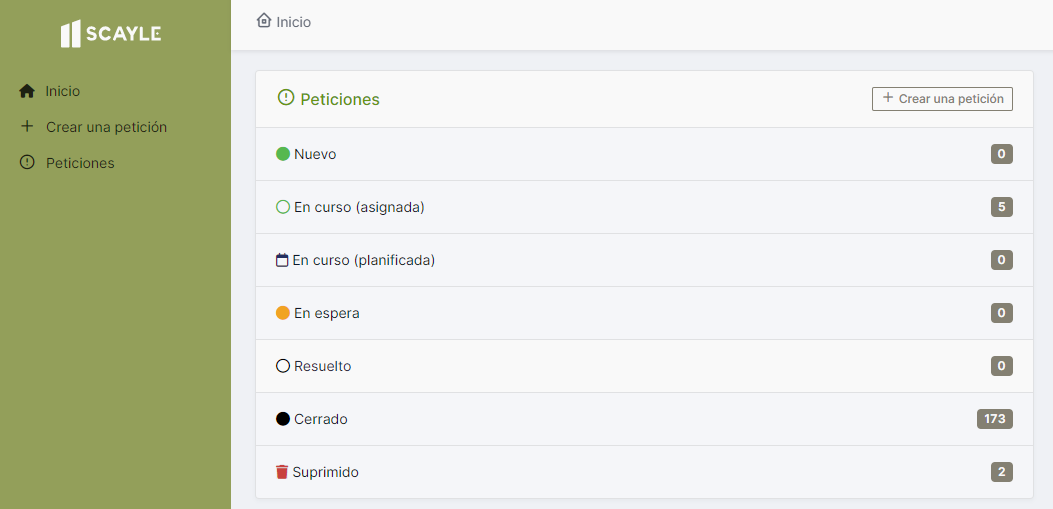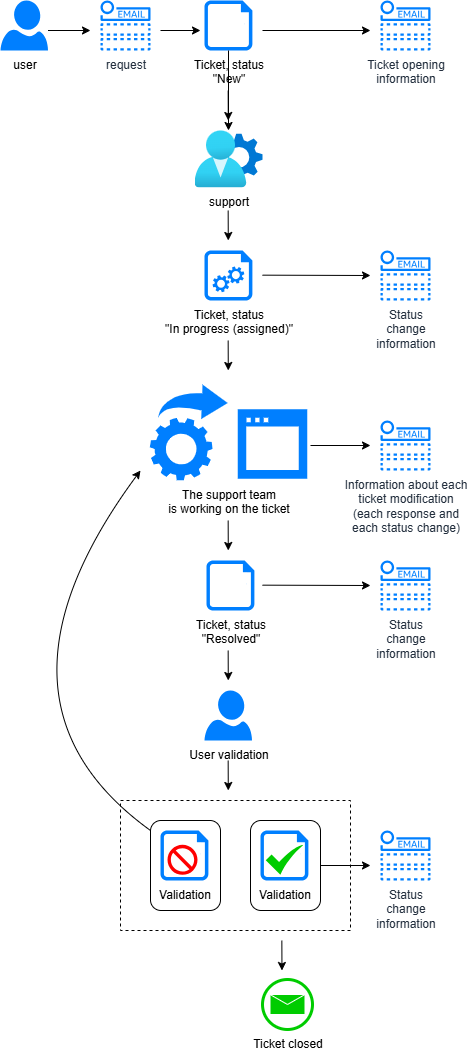GLPI Environment
Once you have accessed the system, to enter the ticketing service, click on "Helpdesk":

Enter the same credentials associated with your account:

Once inside, you can view the status of all requests, as well as create new ones:

In GLPI, tickets go through different statuses to organize and manage their lifecycle. Below, the main statuses are explained, including their meaning and usage.
1. 🆕 New
The New status indicates that the ticket has been created but has not yet been reviewed or assigned.
-
📋 Features:
- The ticket is in its initial phase.
- No actions have been taken yet.
- Pending assignment or initial review.
-
✔️ Common usage:
- This status is assigned automatically when the ticket is created.
- It is the support team's responsibility to review and proceed with its management.
2. 🚀 In Progress (Assigned)
The In Progress (Assigned) status means that the ticket is now in the hands of a technician or responsible team.
-
📋 Features:
- The assigned technician or group is managing the ticket.
- It is in the process of analysis or resolution.
- It may involve exchanges with the user to gather additional information.
-
✔️ Common usage:
- Reflects that the ticket is being worked on.
- Notifies the user that their case has been assigned to a responsible party.
3. 🗓️ In Progress (Planned)
The In Progress (Planned) status indicates that there is a defined plan to resolve the ticket, but it has not yet been executed.
-
📋 Features:
- Includes specific dates for future actions.
- May involve coordination between different teams.
- Useful for complex issues or scheduled projects.
-
✔️ Common usage:
- Used when prior planning is required (e.g., migrations, major changes).
- Reflects that the ticket is in progress but scheduled for execution.
4. ⏳ On Hold
The On Hold status is used when the ticket cannot progress due to external factors.
-
📋 Features:
- Waiting for additional information from the user.
- Depends on suppliers or external approvals.
- Indicates that the ticket is not abandoned but temporarily paused.
-
✔️ Common usage:
- Requesting additional data or documentation from the user.
- Waiting for a response from third parties before continuing with management.
5. ✅ Resolved
The Resolved status means that the issue or request has been successfully addressed.
-
📋 Features:
- All necessary actions have been completed.
- The user has been informed of the solution.
- The ticket no longer requires further technical work.
-
✔️ Common usage:
- The user is notified to confirm whether they are satisfied with the solution.
- If there is no user response, the ticket may be closed automatically after some time.
6. 🔒 Closed
The Closed status indicates that the ticket has been fully completed, and no further actions are expected.
-
📋 Features:
- The user has accepted the solution, or the ticket has remained unanswered.
- Stored as a historical record.
- Cannot be modified but may be reopened if necessary.
-
✔️ Common usage:
- Represents the end of the ticket lifecycle.
- Used after confirming that the issue has been resolved satisfactorily.
7. 🗑️ Deleted
The Deleted status is used for tickets that are no longer relevant.
-
📋 Features:
- Tickets created by mistake or duplicates.
- Removed from the active flow but may remain archived for audits.
-
✔️ Common usage:
- System maintenance to avoid unnecessary ticket overload.
- Generally managed by administrators.
🔄 General Status Flow
- 🆕 New: The ticket is created and awaits review.
- 🚀 In Progress (Assigned): The ticket is assigned to a responsible party.
- 🗓️ In Progress (Planned): A solution has been scheduled.
- ⏳ On Hold: Temporarily paused due to external factors.
- ✅ Resolved: The issue has been addressed.
- 🔒 Closed: The ticket lifecycle is fully completed.
- 🗑️ Deleted: Removed for being irrelevant or duplicated.
These statuses allow for efficient ticket lifecycle management, ensuring clarity for both users and the support team.
The request flow can be graphically seen here:

Remember that tickets without user feedback will be closed after 15 days.
Last updated: 23/09/2025 14:39